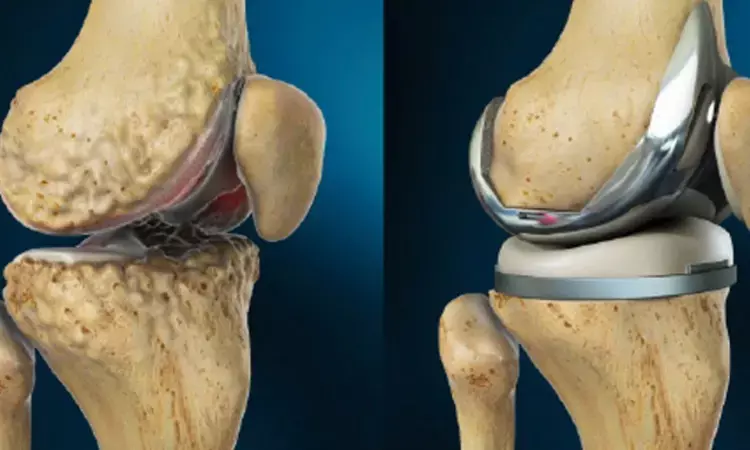- Home
- Medical news & Guidelines
- Anesthesiology
- Cardiology and CTVS
- Critical Care
- Dentistry
- Dermatology
- Diabetes and Endocrinology
- ENT
- Gastroenterology
- Medicine
- Nephrology
- Neurology
- Obstretics-Gynaecology
- Oncology
- Ophthalmology
- Orthopaedics
- Pediatrics-Neonatology
- Psychiatry
- Pulmonology
- Radiology
- Surgery
- Urology
- Laboratory Medicine
- Diet
- Nursing
- Paramedical
- Physiotherapy
- Health news
- Fact Check
- Bone Health Fact Check
- Brain Health Fact Check
- Cancer Related Fact Check
- Child Care Fact Check
- Dental and oral health fact check
- Diabetes and metabolic health fact check
- Diet and Nutrition Fact Check
- Eye and ENT Care Fact Check
- Fitness fact check
- Gut health fact check
- Heart health fact check
- Kidney health fact check
- Medical education fact check
- Men's health fact check
- Respiratory fact check
- Skin and hair care fact check
- Vaccine and Immunization fact check
- Women's health fact check
- AYUSH
- State News
- Andaman and Nicobar Islands
- Andhra Pradesh
- Arunachal Pradesh
- Assam
- Bihar
- Chandigarh
- Chattisgarh
- Dadra and Nagar Haveli
- Daman and Diu
- Delhi
- Goa
- Gujarat
- Haryana
- Himachal Pradesh
- Jammu & Kashmir
- Jharkhand
- Karnataka
- Kerala
- Ladakh
- Lakshadweep
- Madhya Pradesh
- Maharashtra
- Manipur
- Meghalaya
- Mizoram
- Nagaland
- Odisha
- Puducherry
- Punjab
- Rajasthan
- Sikkim
- Tamil Nadu
- Telangana
- Tripura
- Uttar Pradesh
- Uttrakhand
- West Bengal
- Medical Education
- Industry
Low presurgical BMI and high physical activity improves function after total knee arthroplasty: JAMA

Norway: Preoperatively, high physical activity, osteoarthritis severity, and lower body mass index (BMI) are associated with improved function 12 months after total knee arthroplasty (TKA), reports an article published in the JAMA Network Open.
Total knee arthroplasty has evolved over the years since it was first in the early 1970s. The global demand for TKA is increasing at a dramatic rate due to the increased prevalence of osteoarthritis and the aging population. The number of primary TKA procedures is projected to grow immensely in the coming years.TKA is one of the most cost-effective and consistently successful surgeries in orthopedics, for restoring physical function in patients with end-stage osteoarthritis. However, more than 1 in 5 patients do not regain satisfactory physical function after TKA which leads to more expensive revision surgery and an immense burden on the individual, health care system, and socioeconomic levels.
Evidence on factors associated with physical function has been reviewed previously, but findings are contradictory, limited in scope, based on pooled data across short-term and longer-term outcomes, or did not address certainty of evidence. Identification of factors associated with physical function may be warranted to improve outcomes in the patients.
Olsen U., University of Oslo, Norway, and colleagues performed a systematic review and meta-analysis study to identify preoperative and intraoperative factors associated with physical function 12 months after TKA.
The research team searched Medline, Embase, Cumulative Index to Nursing and Allied Health Literature (CINAHL), Cochrane Library, and Physiotherapy Evidence Database (PEDro) for prospective observational studies or RCTs on factors associated with physical function after TKA in adult patients with osteoarthritis.
The team analyzed 20 studies, including 11 317 patients and 37 factors. The primary outcome was set as physical function 12 months after TKA. Secondary outcomes were physical function 3 and 6 months after TKA. All estimates were mean correlations between factors and postoperative function. Positive correlations corresponded to better function.
Key findings of the study,
• Mean correlation with higher BMI, better physical function, and more severe osteoarthritis was estimated to be −0.15, 0.14, and 0.10, respectively.
• In sensitivity analyses, the mean correlation with the better physical function was estimated to be 0.20, a larger coefficient than in the main analysis, while mean correlations were estimated to be similar for other factors (BMI: –0.17; osteoarthritis severity: 0.10).
The authors conclude that there is evidence (with moderate certainty) that higher BMI is correlated with worse physical function and that better physical function (low-certainty evidence) and more severe osteoarthritis (high-certainty evidence) are correlated with better physical function 12 months after TKA.
The present study findings suggest that these factors should be included when testing predictive models of TKA outcomes, the authors wrote.
Reference:
Olsen U, Lindberg MF, Rose C, et al. Factors Correlated With Physical Function 1 Year After Total Knee Arthroplasty in Patients With Knee Osteoarthritis: A Systematic Review and Meta-analysis. JAMA Netw Open. 2022;5(7):e2219636. doi:10.1001/jamanetworkopen.2022.19636
BDS
Dr. Hiral patel (BDS) has completed BDS from Gujarat University, Baroda. She has worked in private dental steup for 8years and is currently a consulting general dentist in mumbai. She has recently completed her advanced PG diploma in clinical research and pharmacovigilance. She is passionate about writing and loves to read, analyses and write informative medical content for readers. She can be contacted at editorial@medicaldialogues.in.
Dr Kamal Kant Kohli-MBBS, DTCD- a chest specialist with more than 30 years of practice and a flair for writing clinical articles, Dr Kamal Kant Kohli joined Medical Dialogues as a Chief Editor of Medical News. Besides writing articles, as an editor, he proofreads and verifies all the medical content published on Medical Dialogues including those coming from journals, studies,medical conferences,guidelines etc. Email: drkohli@medicaldialogues.in. Contact no. 011-43720751


